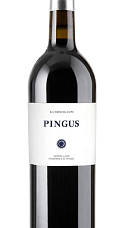Descripción
Posíblemente estemos hablando de uno de los tres vinos más míticos de España. Este Pingus 2017 es una delicia que tiene tras de sí el aval de los mejores críticos nacionales e internacionales. Este es el vino que hace referencia al apodo de niñez de su creador, el danés Peter Sisseck. Cada botella de esta maravilla es un trocito de la Ribera del Duero. Para detener el mundo tras el descorche.
Ficha técnica
Cata
Viñedo y elaboración
Opinión de los críticos
I also tasted the 2017 Pingus, which had a tough competition with the bottled 2016 and a barrel sample of the 2018 (and the fermenting 2019, but that doesn't really count). 2017 was a weird vintage for the zone, as the year was marked by one spring frost that decimated the crop and completely changed the balance of the year. In 2007, they put a windmill in one of the plots, and although the plot was not able to escape the frost, it was not as acute as it was in the Flor de Pingus vineyards, where they lost up to 40% of the crop. At the Pingus vineyards, they lost some 25% of the grapes. They started the élevage in used barriques, where they wine matured for 12 months, and then moved the wine to larger barrels so they could extend the aging. There are alternate sensations of ripeness and herbal aromas. You can see a little bit of the tannic style of a concentrated year (1995, 2004, 2014), which is very different from fluid years like 2016 or 1996, with a rustic Ribera character. They saved the vintage with their knowledge of their vineyards, whereas in the past, a vintage like this could have been a disaster. Sometimes wines like this can have an unexpected development in bottle... 5,700 bottles were filled in July 2019. - Luis Gutiérrez.
The brightness and intensity here is fantastic with density and firmness that is most impressive. Squared-off tannins give this classicism and beauty. Full body. Extremely long and powerful. One to watch.
Deservedly regarded as one of Spain's greatest reds, this is never a blockbuster Tempranillo, even in a year like 2017 when 30% of the crop was lost to frost. Made with 4.5-hectares of old-vine fruit from the Barroso and San Cristóbal pagos, it has youthful flavours of blood orange, black cherry and raspberry and beautifully understated wood. The tannins are silky and refined, the palate very long indeed.









Añadas: 2021 2020 2018 2017
Esta añada no tiene valoraciones todavía. Pincha en las otras añadas para ver sus valoraciones.
Esta añada no tiene valoraciones todavía. Pincha en las otras añadas para ver sus valoraciones.
Esta añada no tiene valoraciones todavía. Pincha en las otras añadas para ver sus valoraciones.
Esta añada no tiene valoraciones todavía. Pincha en las otras añadas para ver sus valoraciones.